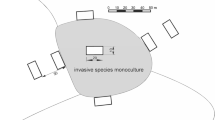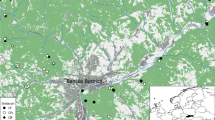Abstract
Conservation and sustainable forestry are essential in a multi-functional landscape. In this respect, ecological studies on epiphytes are needed to determine abiotic and biotic factors associated with high diversity. The aim of the present study was to evaluate relative sensitivity of conservation targets (epiphytic bryophytes and lichens) in relation to contrasting environmental variables (tree species, tree diameter at breast height, bark crevice depth, pH, tree inclination, pH, forest stand age, area and type) in boreo-nemoral forests. The study was conducted in Latvian 34 woodland key habitat (WKH) boreo-nemoral forest stands. Generalized linear mixed models and canonical correspondence analysis showed that tree species and tree bark pH were the most important variables explaining epiphytic bryophyte and lichen composition and richness (total, Red-listed, WKH indicator species). Forest stand level factors, such as stand size and habitat type, had only minor influence on epiphytic species composition and richness. The results of the present study indicate a need to maintain the diversity of tree species and large trees, particularly Acer platanoides, Carpinus betulus, Fraxinus excelsior, Populus tremula, Tilia cordata, Ulmus glabra and Ulmus laevis in conservation of epiphytic bryophyte and lichen communities in the future.


Similar content being viewed by others
References
Abolin AA (1968) Listostebelnije mhi Latviskoy SSR. Zinatne, Riga
Āboliņa A (1994) Latvijas retās un aizsargājamās sūnas. LU ekoloǵiskā centra apgāds, Rīga
Aude E, Poulsen RS (2000) Influence of management on the species composition of epiphytic cryptogams in Danish Fagus forests. Appl Veg Sci 3:81–88
Baldwin LK, Bradfield GE (2007) Bryophyte responses to fragmentation in temperate coastal rainforests: a functional group approach. Biol Conserv 136:408–422
Barkman JJ (1958) Phytosociology and ecology of cryptogamic epiphytes. Van Gorcum, Assen
Bates JW (1992) Influence of chemical and physical factors on Quercus and Fraxinus epiphytes at Loch Sunart, Western Scotland: a multivariate analysis. J Ecol 80:163–179
Belinchòn R, Martinez I, Escudero A, Aragòn G, Valladares F (2007) Edge effects on epiphytic communities in a Mediterranean Quercus pyrenaica forest. J Veg Sci 18:81–90
Berg Å, Gärdenfors U, Hallingbäck T, Norén M (2002) Habitat preferences of red-listed fungi and bryophytes in woodland key habitats in southern Sweden-analysis of data from the National survey. Biodivers Conserv 11:1479–1503
Berglund H, Jonsson BG (2003) Nested plant and fungal communities; the importance of area and habitat quality in maximizing species capture in boreal old-growth forests. Biol Conserv 112:319–328
Billings WD, Drew WB (1938) Bark factors affecting the distribution of corticolous bryophytic communities. Am Midl Nat 20:302–330
Bolker BM, Brooks ME, Clark CJ, Geange SW, Poulsen JR, Stevens MHH, White JS (2008) Generalized linear mixed models: a practical guide for ecology and evolution. Trends Ecol Evol 24:127–135
Braak CJF, Šmilauer P (2002) Canoco reference manual and canocodraw for windows user’s guide: software for Canoco community ordination (version 4.5). Microcomputer, Ithaca
Brūmelis G, Jonsson BG, Kouki J, Kuuluvainen T, Shorokhova E (2011) Forest naturalness in northern Europe: perspectives on processes, structures and species diversity. Silva Fennica 45(5):807–821
Cieśliński S, Czyżewska K, Klama H, Żarnowiec J (1996) Part three. Use of forest environment by cryptogamous plants, 13. Epiphytes and epiphytes. Phytocoenosis 8:15–35
Ek T, Suško U, Auziņš R (2002) Methodology. Inventory of woodland key habitats. Forest State Service, Latvia, Regional Forestry Board, Riga
Frego KA (2007) Bryophytes as potential indicators of forest integrity. For Ecol Manag 242:65–75
Glime JM (2007) Bryophyte ecology, vol 1. Physiological ecology. Ebook sponsored by Michigan Technological University and the International Association of Bryologists. http://www.bryoecol.mtu.edu/. Accessed 10 October 2009
Grolle R, Long D (2000) An annotated check-list of the Hepaticae and Anthocerotae of Europe and Macaronesia. J Bryol 22:103–140
de Groot R (2006) Function-analysis and valuation as a tool to assess land use conflicts in planning for sustainable, multi-functional landscapes. Landscape Urban Plan 75:175–186
Gustafsson L, Eriksson I (1995) Factors of importance for the epiphytic vegetation of aspen Populus tremula with special emphasis on bark chemistry and soil chemistry. J Appl Ecol 32(2):412–424
Gustafsson L, De Jong J, Norén M (1999) Evaluation of Swedish woodland key habitats using Red-listed bryophytes and lichens. Biodivers Conserv 8:1101–1114
Gustafsson L, Hylander K, Jacobson C (2004) Uncommon bryophytes in Swedish forests-key habitats and production forests compared. For Ecol Manag 194:11–22
Hedenås H, Ericson L (2000) Epiphytic macrolichens as conservation indicators: successional sequence in Populus tremula stands. Biol Conserv 93:43–53
Hill MO, Bell N, Bruggeman-Nannenga MA, Brugués M, Cano MJ, Enroth J, Flatberg KI, Frahm J, Gallego MT, Garilleti R, Guerra J, Hedenäs L, Holyoak DT, Gyvönen J, Ignatov MS, Lara F, Mazimpaka V, Muńoz J, Söderström L (2006) An annotated checklist of the mosses of Europe and Macaronesia. bryological monograph. J Bryol 28:198–267
Holien H (1996) Influence of site and stand factors on the distribution of crustose lichens of the caliciales in a suboceanic spruce forest area in Central Norway. Lichenologist 28(4):315–330
Jüriado I, Paal J, Liira J (2003) Epiphytic and epixylic lichen species diversity in Estonian natural forests. Biodivers Conserv 8:1587–1607
Jüriado I, Liira J, Paal J, Suija A (2009a) Tree and stand level variables influencing diversity of lichens on temperate broad-leaved trees in boreo-nemoral floodplain forests. Biodivers Conserv 18:105–125
Jüriado I, Liira J, Paal J (2009b) Diversity of epiphytic lichens in boreo-nemoral forests on the North-Estonian limestone escarpment: the effect of tree level factors and local environmental conditions. Lichenologist 41(1):81–96
Kouki J, Arnold K, Martikainen P (2004) Long-term persistence of aspen––a key host for many threatened species––is endangered in old-growth conservation areas in Finland. J Nat Conserv 12:41–52
Kuusinen M (1994) Epiphytic lichen diversity on Salix caprea in old-growth southern and middle boreal forests of Finland. Ann Bot Fenn 31:77–92
Kuusinen M (1996) Epiphyte flora and diversity on basal trunks of six-growth forest tree species in southern and middle boreal Finland. Lichenologist 28:443–462
Larsen RS, Bell JNB, James PW, Chimonides PJ, Rumsey FJ, Tremper A, Purvis OW (2006) Lichen and bryophyte distribution on oak in London in relation to air pollution and bark acidity. Environ Pollut 146:332–340
Latvijas dabas fonds (2007) Aizsargājamo ainavu apvidus “Ziemeļgauja”. Dabas aizsardzības plāns, Rīga
Löbel S, Snäll T, Rydin H (2006) Species richness patterns and metapopulation processes-evidence from epiphyte communities in boreo-nemoral forests. Ecography 29:169–182
Madžule L, Brūmelis G, Tjarve D (2012) Structures determining bryophyte species richness in a managed forest landscape in boreo-nemoral. Eur Biodivers Conserv 21:437–450
Mežaka A, Brūmelis G, Piterāns A (2008) The distribution of epiphytic bryophyte and lichen species in relation to phorophyte characters in Latvian natural old-growth broad leaved forests. Folia Cryptogam Estonica 44:89–99
Ojala E, Mönkkönen M, Inkeröinen J (2000) Epiphytic bryophytes on European aspen Populus tremula in old-growth forests in northeastern Finland and in adjacent sites in Russia. Can J Bot 78:529–536
Orange A, James PW, White FJ (2001) Microchemical methods for the identification of lichens. Br Lichen Soc 97:69–79
Palmer MW (1986) Pattern in corticolous bryophyte communities of the North Carolina Piedmont: do mosses see the forest or the trees? Bryologist 89:59–65
Paltto H, Nordén B, Götmark F, Franc N (2006) At which spatial and temporal scales does landscape context affect local density of Red data book and Indicator species. Biol Conserv 133:442–454
Piterāns A (2001) Latvijas ķērpju konspekts. Latvijas Veģetācija 3:5–46
Prieditis N (2002) Evaluation frameworks and conservation system of Latvian forests. Biodivers Conserv 11:1361–1375
Pykälä J, Heikkinen RK, Toivonen H, Jääskeläinen K (2006) Importance of forest act habitats for epiphytic lichens in Finnish managed forests. For Ecol Manag 223:84–92
Ranius T, Johansson P, Berg N, Niklasson M (2008) The influence of tree age and microhabitat quality on the occurrence of crustose lichens associated with old oaks. J Veg Sci 19:653–662
Sjörs H (1963) Amphi-Atlantic zonation nemoral to Arctic. In: Löve A, Löve D (eds) North Atlantic biota and their history. The Macmillan Company, New York, pp 109–125
Slack NG (1976) Host specificity of bryophytic epiphytes in eastern North America. J Hattori Bot Lab 41:107–132
Smith AJA (1982) Epiphytes and epiliths. In: Smith AJA (ed) Bryophyte ecology. Chapman & Hall, London
Snäll T, Ehrlén J, Rydin H (2005) Colonization-extinction dynamics of an epiphyte metapopulation in a dynamic landscape. Ecology 86:106–115
Stringer PW, Stringer MHL (1974) A quantitative study of corticolous bryophytes in the vicinity of Winnipeg, Manitoba. Bryologist 77:551–560
Szövényi ZSH, Tóth Z (2004) Phorophyte preferences of epiphytic bryophytes in a stream valley in the Carpathian Basin. J Bryol 26:137–146
The Council of the European Communities 1992 (EU 1992). Council Directive 92/43/EEC on the Conservation of natural habitats and wild fauna and flora. Official Journal L 206, 22/07/1992 P. 0007–0050
Trynoski SE, Glime JM (1982) Direction and height of bryophytes on four species of Northern trees. Bryologist 85:281–300
Uliczka H, Angelstam P (1999) Occurrence of epiphytic macrolichens in relation to tree species and age in managed boreal forest. Ecography 22:396–405
Venables WN, Smith DM, R development team (2008). An introduction to R
Villard MA, Jonsson BG (2009) Setting conservation targets for managed forest landscapes. Conservation biology 16. Cambridge University Press, Cambridge
Vimba E, Piterāns A (1996) Red data book of Latvia. Rare and endangered species of plants and animals. Fungi and Lichens, Riga
VMD (2009) Homepage of Latvian State Forest Agency. http://www.vmd.gov.lv/?sadala=2. Accessed 1 October 2009
Wirth V (1995a) Die Flechten baden-württembergs. Teil 1. Eugen Ulmer, Stuttgart
Wirth V (1995b) Die Flechten baden-württembergs. Teil 2. Eugen Ulmer, Stuttgart
Acknowledgments
Thanks is given to Ligita Liepiņa (University of Latvia), Austra Āboliņa, Baiba Bambe for help in bryophyte identification. We are thankful to Vija Znotiņa for the fruitful discussions in early stages of the study. Thanks is given to Didzis Elferts for suggestions in statistical analysis. The present work is partly financially supported by projects - European Social Fund (ESF2004/0001/VPD1/ESF/PIAA/04/NP/3.2.3.1/0001/0001/0063), University of Latvia research project ZP2008/ZP08, Latvian Academy of Sciences grant 05.1512/147, Ministry of Education, Youth and Sport of the Czech Republic, DBU Stipendium für Nachwuchswissenschaftler, Forest Development Fund (grant Nr.180909/S96), European Community Mobility Programme Erasmus Mundus Action 2, Strand 1 (EMA2), Triple I 2011/2012. Thanks is given for three anonymous reviewer’s for valuable comments in manuscript improvement.
Author information
Authors and Affiliations
Corresponding author
Appendix
Appendix
See Table 4.
Rights and permissions
About this article
Cite this article
Mežaka, A., Brūmelis, G. & Piterāns, A. Tree and stand-scale factors affecting richness and composition of epiphytic bryophytes and lichens in deciduous woodland key habitats. Biodivers Conserv 21, 3221–3241 (2012). https://doi.org/10.1007/s10531-012-0361-8
Received:
Accepted:
Published:
Issue Date:
DOI: https://doi.org/10.1007/s10531-012-0361-8




